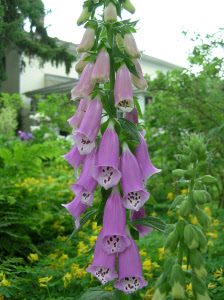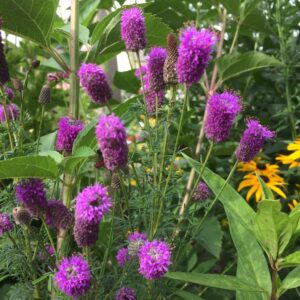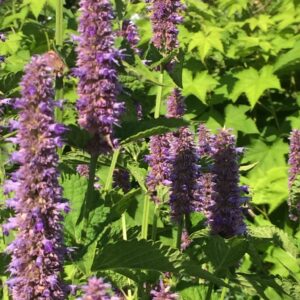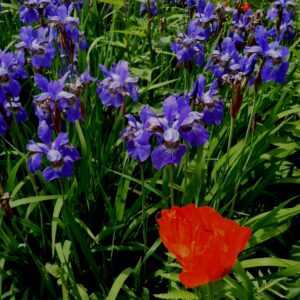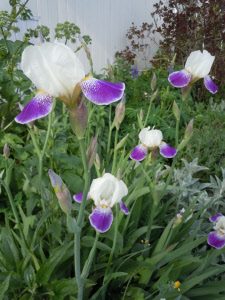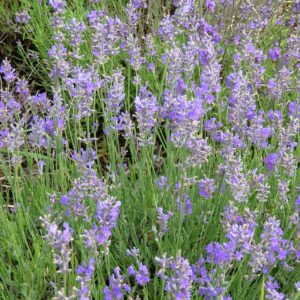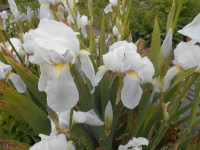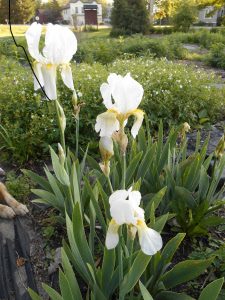Search Results for: bleeding heart vine
-
Digitalis purpurea Foxglove Z 4-8
OUT OF STOCK Early summer pink, purple or white spires of spotted bells. Beautiful....
OUT OF STOCK
Early summer pink, purple or white spires of spotted bells. Beautiful.
Size: 3-5' x 24"
Care: Part shade moist well-drained soil. Deer resistant
Native: Great Britain,west and central Europe east to Scandinavia, often escapes.Druids were fond of this Foxglove because it flowered at the same time as their midsummer sacrifice. First described by German physician and botanical author Leonhard Fuchs (1501-1566). Grown in Medieval gardens. The plant’s use as a heart stimulant was discovered in 1775 by English physician William Withering. The word ‘fox’ is said to be a corruption of ‘folk,’ meaning the ‘little folk’ or fairies,” having the power to ward off witches and return children kidnapped by fairies. Cultivated in America since 1700’s, with the first documented reference of American cultivation in 1748 by Peter Kalm, a student of Linneaus and a Swedish botanist who explored colonial America for plants. Pressed specimen in Emily Dickinson’s herbarium.
-
Dalea purpurea syn. Petalostemon purpurea Violet prairie clover Z 4-9
Vase shaped clump with wands of violet to purple encircling tall coneheads mid-summer
Vase shaped clump with wands of violet to purple encircling tall coneheads mid-summer
Size: 2’ x 18”
Care: full sun in well-drained to moist well-drained soil.
Native: Canada to Texas, Wisconsin native
Wildlife Value: Host for caterpillars of Dogface Sulphur, Striped blue & Mexican blue butterflies. Supports over 80 bee species including endangered Rusty patched Bumble BeesDalea named to honor English botanist Dr. Samuel Dale (1659- 1739.) Chippewa, Meskwaki and Navajo used medicinally – as remedies for heart ailments, pneumonia, diarrhea and measles. Comanche and Lakota chewed the root like gum, for its sweet taste. Sioux combined it with Amorpha canescens, Leadplant to ambush bison. Sioux also treated fevers and stomach disorders with an infusion made from the plant. Pawnee made brooms from the flexible stems. 1st collected by French botanist André Michaux (1746-1802) who spent 11 years in America collecting hundreds of new plants.
-
Papaver orientale ‘Beauty of Livermere’ Z 3-9
Glossy fire engine red petals with black heart in June....
ARCHIVED
Note: This is a plant not currently for sale. This is an archive page preserved for informational use.
Scarlet, tissue-thin petals surround a purple blotch at the base highlighted with purple stamens
Size: 3' x 2'
Care: sun in well-drained soil. Foliage dies back in summer & reemerges in the cool autumn.
Wildlife Value: Attracts hummingbirds, bees & butterflies. Deer & rabbit resistant.This red selection listed in Matineau’s book 1910
-
Agastache foeniculum Anise hyssop Z 4-8
Purplish-blue spikes from July to October. Fragrant foliage....
Purplish-blue spikes from July to October. Fragrant foliage.
Size: 2-3' x 12"
Care: Full sun in well-drained soil, heat and drought tolerant.
Native: North America, Wisconsin native.
Wildlife Value: Skipper butterflies and Rusty patched Bumble Bees love Anise hyssop’s nectar, deer resistant.The name Agastache is from Greek agan and stachys meaning much like an ear of wheat referring to the shape of the flower spike. Anise hyssop leaves were used by American Americans of the Missouri River region to make tea and as a sweetener in cooking. For Cheyenne it relieved chest pain due to coughing or to a dispirited heart. Listed as an aromatic herb in McMahon’s 1805 book.
-
Iris siberica Siberian Iris Z 4-9
Narrow, sword shaped leaves with blue, purple, or white Iris flowers in June....
Narrow, sword shaped leaves with blue, purple, or white Iris flowers in June.
Size: 3-4' x S 12" and spreading
Care: Full sun moist well-drained soil. Deer resistant, Walnut toxicity resistant and drought tolerant.
Native: Eastern Siberia
Awards: England's Royal Horticultural Society Award of Merit.Iris is named after the Greek goddess who accompanied the souls of women to the Elysian Fields by way of the rainbow. Her footprints left flowers the colors of the rainbow. Iris means the “eye of heaven.” The iris is the flower of chivalry, having “a sword for its leaf and a lily for its heart.” Ruskin. Siberian Irises first cultivated in European gardens in the 1500’s. Blue Siberian Iris was introduced to the U.S. in 1796. Cultivated by Washington at Mount Vernon.
-
Iris ‘Wabash’ Z 5-8
Pure white standards with deep violet falls edged in white in late May-early June.
Pure white standards with deep violet falls edged in white in late May-early June.
Size: 39" x 8"
Care: sun in moist well-drained soil.
Awards: Dykes award (best iris) winner 1940.Iris is named after the Greek goddess who accompanied the souls of women to the Elysian Fields by way of the rainbow. Her footprints left flowers the colors of the rainbow. Iris means the eye of heaven. The iris is the flower of chivalry, having “a sword for its leaf and a lily for its heart.” Hybridized by Williamson in 1936
-
Lavandula angustifolia ‘Munstead’ Z 5-9
June and rebloom in late summer, very fragrant lavender spikes...
June and rebloom in late summer, very fragrant lavender spikes
Size: 12-18” x 12-18”
Care: Sun, well drained moderately fertile soil
Native: Selection of Western Mediterranean nativeThis selection introduced to gardens in 1916. Name is Latin from “lavare” meaning to wash because Romans used lavender to scent their baths. Ancient Phoenicians used lavender to make perfume. Cultivated in Islamic gardens by 1050 A.D. Queen Elizabeth, I ate lavender conserve, made by adding sugar to the flowers while Charles VI of France stuffed pillows with lavender and sat on them. Culpepper, a 16th century English herbalist, wrote that lavender grew in almost every garden and cured headache, apoplexy, dropsy, fainting, toothaches, and “passions of the heart.” Jefferson grew it with herbs at his farm, 1794.
-
Iris florentina Florentine iris, White flag Z 3-9
Sweetly fragrant, tall, icy blue-white iris with pale yellow signal on the fall, flowering in June
Sweetly fragrant, tall, icy blue-white iris with pale yellow signal on the fall, flowering in June
Size: 24-30” x 18-24”
Care: sun in moist well-drained soil. Plant with rhizome tops above soil.
Native: Italy and southern France
Wildlife Value: welcomes bees with easy access to pollenIris is named after the Greek goddess who accompanied the souls of women to the Elysian fields by way of the rainbow. Her footprints left flowers the colors of the rainbow. Iris means “eye of heaven.” The iris is the flower of chivalry, having “a sword for its leaf and a lily for its heart.” Ruskin. At least 2000 years old, this was identified by Dioscorides in De Materica Medica for medicinal use around 70 A.D. English herbalist John Gerard grew it by 1596. Grown in the Eichstätt Garden, the garden of Johann Konrad von Gemmingen, prince bishop of Eichstätt in Bavaria, c. 1600. Grown at America’s 1st botanic garden, Elgin Botanic Garden 1811. Its rhizome is the source of dried orris root. Dig in late summer, peel, chop, dry, age, and then grind into a powder which is a scent fixative for perfumes and potpourris and flavoring for Chianti wine. Orris root has a violet-like aroma. Add powder directly to potpourris. Mix with oil prior to adding to perfumes.
-
Iris ‘Polar King’ Z 4-9
Pure white with yellow falls, vigorous reblooming iris. Blooms in spring and again, sporadically, in fall....
Pure white with yellow falls, vigorous reblooming iris. Blooms in spring and again, sporadically, in fall.
Size: 34”x8” Vigorous & spreads by rhizomes.
Care: Sun in moist well-drained to well-drained soil. Plant with rhizome tops above soil.
Awards: American Iris Society Award of MeritIris is named after the Greek goddess who accompanied the souls of women to the Elysian fields by way of the rainbow. Her footprints left flowers the colors of the rainbow. Iris means “eye of heaven.” The iris is the flower of chivalry, having “a sword for its leaf and a lily for its heart.” Ruskin. This hybrid bred by Thomas Donahue of Newton Lower Falls, Massachusetts. He 1st showed it at the Massachusetts Horticultural Society flower show in October of 1931 where it won several awards. Registered in 1939.
-
Asarum canadense syn. Hexastylis canadense Wild ginger Z 3-7
Concealed brown bell-shaped flowers with flared tips hide under this groundcover’s crinkled, lacquered leaves....
Concealed brown bell-shaped flowers with flared tips hide under this groundcover’s crinkled, lacquered leaves.
Size: 6" x 6" spreading
Care: part shade to shade, moist well-drained to well-drained soil
Native: Canada to So. Carolina, Wisconsin nativeNative Americans used Wild ginger for such diverse purposes as flavoring food, curing heart palpitations, induce menstrual cycles, cure “the bite of the serpent,” mend broken bones, as a general tonic, a tea and lure catfish. Winnebago tenderized raccoon meat with this. Colonists used the plant to break fever and stimulate the appetite.

